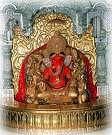The
following temple is a testimony that the "Hinduism" is not a religion,
but a way of life. This temple is UNIQUE and one of its kinds. The
temple that I’m referring to is Sri Ajaatha Nagalinga Swamy Mata in
Navalagunda town in Darward Dist., Karnataka, India. Sri Ajaatha
Nagalinga Swamy is a 19th
century Yogi. He was born in Javalagi Village in Sindhanur town of
Raichur Dist., Karnataka. He became a yogi at a very young age. He spent
his initial life in wondering around, doing miracles, and helping
people in distress. He finally settled down at the Mouneshwara cave
temple in Dharwad. His teachings were very simple and anyone could
easily understand and put it in to practice. He preached; ''Ones heart
is the temple while ones soul is the god''. So, one has to have a clean
and pure heart. He believed in Advaitha philosophy. In his times he was
very popular among villagers, still he is. He has many devotees and many
followers.
 |
| Ajaatha Nagalinga Swamy |
He
is a yogi who has uncanny resemblance to Jesus Christ. The Picture of
Sri Ajaatha Nagalinga Swamy’s hung on the temple walls will concur with
my comparison. When there is a mention of Jesus Christ then there should
some reference to Bible. Yes, you read me right. There is indeed a very
sacred book here and that is the BIBLE. Bible is the sacred book in
this Hindu temple. Everyday, the temple priest offers prayers as per
Hindu tradition and is kept for display. Every devotee who comes to this
temple pays his/her prayers to the bible aswell. Bible written in
Kannada-the official language of Karnataka state is not read in this
temple. Although, bible is very sacred here it is not a ‘CHURCH’ but a
‘HINDU’ Temple.
 |
| Bible @ the sacred sanctum |
The miracle of this temple is the bible, which is
growing
on its own. There is a very interesting story as how this Bible reached
this temple. This Bible is one book and has both Old and
New Testaments. Once lived a great Devi devotee by the name Kalappa in
Mushteegeri village of Badami town in Bagalkote dist, Karnataka. Kalappa
also showed interest in Bible reading; he had a first edition of bible
(published in 1865 by Watson machine prints). Sri Ajaatha Nagalinga
Swamy met Kalappa and prophesied his next birth. He took the bible from
Kalappa, drilled a hole on it with the help of a hook (used to peel
coconut from its shell). The yogi then dropped a 1 Re Victorian silver
coin in to the perforation. It came out from the other end smoothly. He
informed Kalappa that the hole will completely close on its own and when
it does, he will be born again in a different avatar. From that day
on, the hole started closing.. subsequently the missing words on the
bible reappeared magically. As of today, the hole is a size of a needle.
Yogi passed away in 1881. The yogi’s followers have erected the place
where he is buried, a Shiva lingam. Late Kalappa gave away the Bible to
the temple. To this date, the Bible and the Silver coin are preserved in
this temple with great care and devotion. And Temple officials have
recorded the radius of this hole regularly. Anyone can access it,
ofcourse with temple authorities permission.
 |
| Bible and the coin |
 |
| Thole that is closing on its own |
 |
| The coin that was dropped inside the hole |
 |
initial measurement were recorded on the bible itself
|
 |
| Official records of the measurement |
Besides
bible, there are also some interesting items in this temple like the
‘Panja’ (The sword used during Muslim festival ‘Moharam’) and a “Cart”
(sidagi in Kannada) used to carry the dead to the burial ground in this
very same temple. No where else you will see bible, panja or the cart
together in a hindu temple. This Sidagi was used as yogi’s chariot. Yogi
used to sit on it and his followers carried him around. Yogi first
found this abandoned cart at a graveyard, and requested his students to
carry it while he sat on it. He requested to go around the village. Many
villagers objected to this procession, as it is very uncommon for a
living person to use a sidagi. Those who objected were mysteriously
died, and some faced weird difficulties. They understood that yogi was
not an ordinary person and then on they too became a staunch follower
of the yogi. Thereby, yogi attracted many devotees from all walks of
life. Today, female devotees tie green bangles in memory of yogi’s
greatest devotee Beemavva to this cart for either for a prosperous
marriage or for children. All their wishes have come true. Sometimes
bangles are tied for various reasons too. Moharam too is celebrated in
this Hindu temple. This temple resonates communal harmony from every
nook and corner.
 |
| Panja |
 |
| Sidagi |
Although,
yogi is not physically present, some devotees claim they have seen the
yogi, while some others say they have heard the yogi speaking, either
ways people in this region have great respect for the yogi, who has
taught that making peace is more important than making war. This indeed
will be one of my favorite Temple stories to this date.
 |
| The arier view of the temple/mutt |
 |
| The Entrence |
 |
| The cave temple |
 |
| The cave temple 1 |
















No comments:
Post a Comment